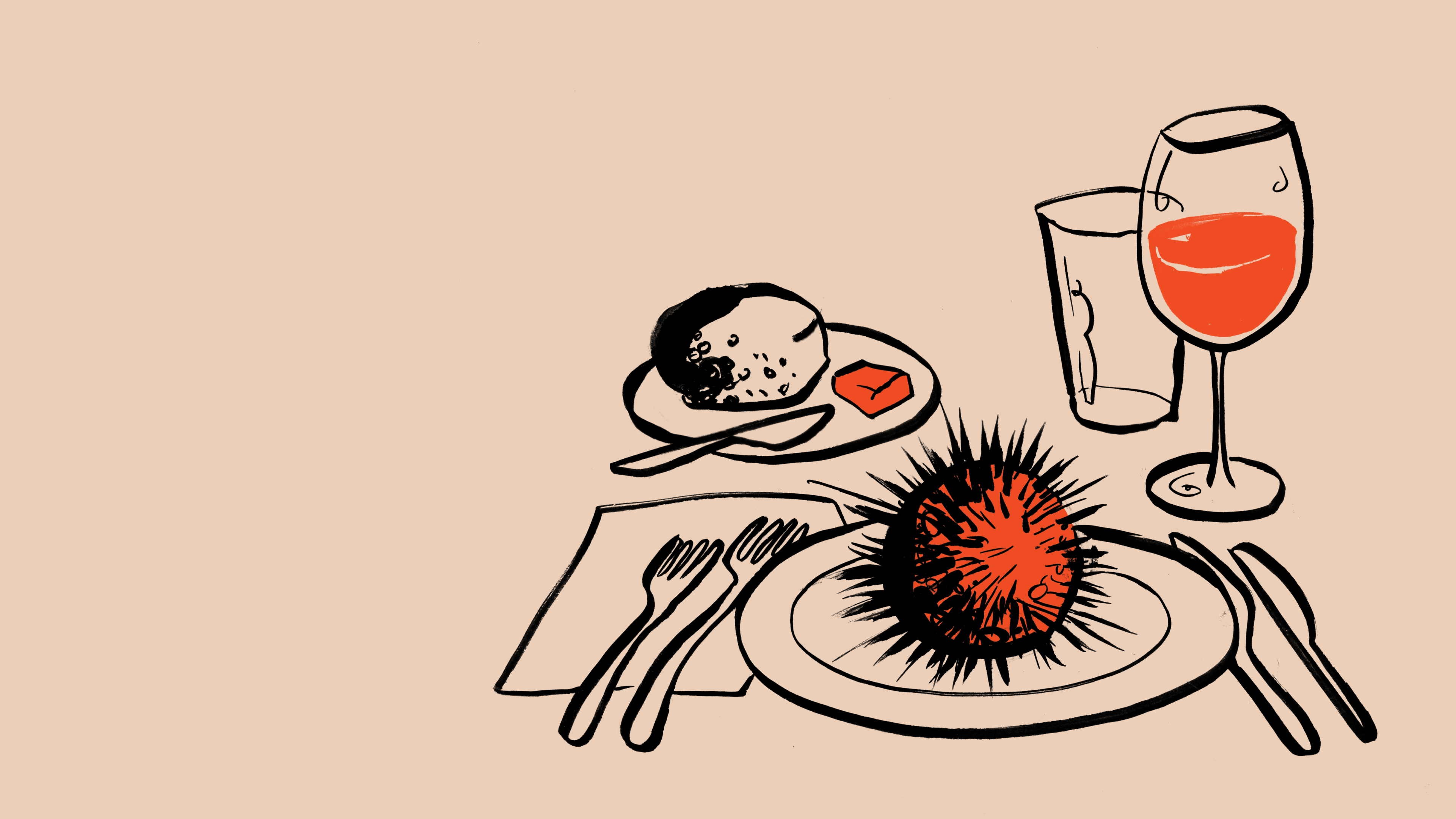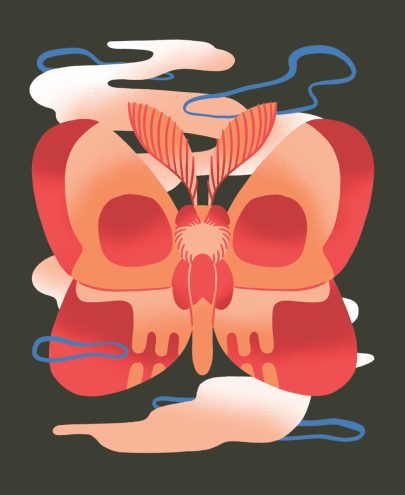Apr 14, 2025 Society
In the corners of social media frequented by Māori, kai takes on a prismatic form. ‘Kai Māori’ might be defined as dishes you’d expect to find on the table in a marae wharekai, but also literally anything else consumed or caught or cooked by Māori. And within this complex constellation of food, the kina, the endemic echinoderm of Aotearoa, has become the central, barbed star.
Kina content could easily be classified as its own social media genre. The spooky, spindly shells of sea urchins and their apparently acquired taste are all over the place. In short clips, mostly on TikTok, immense tangerine-coloured roe are sucked up dramatically on the beach as if they’re ramen noodles — with a theatrical kina slurp that is a central, albeit contentious, convention within the genre. Some kina are downed, mukbang-style, from punnets with plastic forks in the front seats of cars — gulped one after another after another. There are ASMR variants, involving, naturally, exaggerated slurping. Kids devour the delicacy from prams. Kaumātua from fold-out chairs.
There are further subgenres dedicated to ‘eating kina for the first time’ and ‘eating kina in Australia’. On Māori-populated Facebook groups where kai content of all kinds is shared, it is the images of kina — piled in buckets; or next to lighters or beer bottles for size comparisons; or the roe perched on toasted bread (with butter, jam, peanut butter or honey and chopped banana) or madeira cake, or even scooped on to ice cream — that seem to engender the most animated responses: “Mean!” “Fat as!” “Better stock up on the gout pills!”
Every genre has its superstars, and for kina content, one is TikTokker and Instagrammer Raukura Huata (@raukurahuata) who has built a following with her aspirational approach to kina-eating — even among Māori who don’t actually enjoy eating it. In a style that some of her followers call “bougie”, she consumes her kina from BYO punnets smuggled into smart-casual restaurants like Hugo’s or Beau , or after hīkoi paired with a glass of bubbles, or by way of chopsticks — sometimes while wearing silk shirts and pearls, too. On the more rugged end of the spectrum, and the country, Te Waipounamu-based Terressa Kollat (@terressakollat) has amassed 12.9 million views on a TikTok video in which she’s seen, wetsuit-clad, with hair still damp and balanced on a rock, prying open a kina with a hunting knife. Then she scoops out the roe with her hands and eats it. (Important note: neither of these superstars slurp their kina.)
All this new internet interest is not to say that kina haven’t always been considered cool among Māori. We have been eating the delicacy raw, preserved and poached in shells since we arrived in Aotearoa, and probably even before that — it’s a perpetual food trend. But right now kina are really, really cool; and they’ve become a symbol of resilience. As the government continues along its path of eroding Māori rights, and hitting in the process new lows in the Māori–Crown relationship by the day, material culture and customs like kina and kina-eating have taken on new cultural and political weight. Calls for kotahitanga and unity among Māori have set alight a sea of hīkoi-joiners, a furore of submission-writing and plenty of acts of defiance — but also an exhilarating flow of symbolic nods towards solidarity and shared identity: tino rangatiratanga flags, Stetson hats, red bands and the eating of kaimoana.
The idea of food being linked to collective identity is not a particularly groundbreaking one. Food has always been deeply intertwined with indigenous identity, and people the world over forge connections through food. The way a group eats — or doesn’t — is a powerful expression of unity and distinction from others. However, the kina has taken on an even more poignant role within this identity-building. The enigmatic nature of these creatures confers them a symbolic weight unmatched by other beloved kaimoana like kūtai, tio, pāua, tuangi, kōura — each delicious and culturally significant, too. But nothing has quite the same twinkle as kina — at least on the internet.
Perhaps this is because, more than most seafood, kina have long been a subject of Pākehā derision and as a result embracing them conveys a clear-cut rejection of conventional Western norms. Kina are bizarre, gory-looking creatures: black thorn-covered orbs, filled with slimy organs, purple liquid and those crucial orangey lobes — a blend of savoury, metallic, bitter, acidic, briny and creamy all at once. A stark contrast to Western ideas of ‘edibility’. In 1908, in 300 Choice Recipes: Souvenir of All Nations Fair, Mrs Keita Kōhere (the wife of Ngāti Porou Anglican clergyman Reverend Rēwiti Kōhere) wrote that “once prejudice is overcome Kina will be found juicy, tasty, and wholesome; a fit dish for epicures”. There’s a charming, futurist outlook to this note, but the sentiment also underscores an awareness of Pākehā distaste for kina, which persists today.
So for Māori, perhaps, beyond pure gastronomic enjoyment, the unusual and supposedly difficult nature of kina might be at least part of the allure. Eating kina represents an embrace of the foods that sustained our ancestors and, at the same time, a deliberate rejection of imposed forms of respectability. Eating kina with jam for breakfast, in great lip-smacking gulps, or hand-scooping the contents of the shell in all its goriness only emphasise the defiant challenge. Disgust, after all, is nothing new for Māori — or for any colonised peoples. Part of the very nature of colonisation is that our culture, our beliefs, our desires, even our cravings are framed as wrong, unwanted, even revolting. And conversely, that Western culture is ordinary, normal and good. These spiky little taonga challenge us to disregard colonial framings, to be unapologetically ourselves, slurps and all. Mrs Kōhere, presumably, would be delighted by the Māori epicures of TikTok.
Recently, I had kina fresh from the shell for the first time. I have eaten a lot of kina in my life, but it has always been from the pottle, and usually obtained from the St Lukes branch of St Pierres. This generous heap of fresh kina had been gathered and gifted to me by a friend, and I invited my parents over to help me eat them. Realising, with a slight fluster, that I had no idea how to get past the spikes, I watched a YouTube video of Piri Weepu demonstrating various techniques for opening them. The method I picked seemed the least hazardous: two spoons pressed gently into the top of the spine to split the brittled shell in half (keep calm, Piri’s on). Calmly, like a pro (sort of), I cracked open the shells and handed them to my mum — my Pākehā dad even tried one.
I didn’t take any videos, or photos, and I am sad to report that there was no slurping. Even so, it was a reminder of the way that food, more than most things, unites and embeds us, acts as a manifestation of the complex web of whanaungatanga and whakapapa: connecting us to the gods, the sea, our ancestors, the people who gathered the food, our friends, our parents, our favourite TikTokkers, and sometimes even Piri Weepu.






